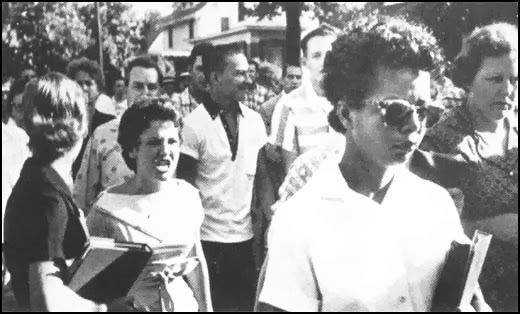Up Close and Personal
 When my hometown was placed under federal mandate to
When my hometown was placed under federal mandate to
desegregate the schools, my mother was selected as the first black teacher to
move to an all white school. I say “selected” because as we know from Martin
Luther King and Rosa Parks, these are carefully orchestrated moments. She had taught at a rural school up to that
point, loved the students, their parents and the community that grew up around
the school, but recognized this as a charge she would have to keep.
One day, she walked into the teachers’ lounge in the middle
of an intense conversation among the teachers, so intense, in fact, that they
missed their usual cue. Usually
conversation would come to a screeching halt when she entered, everybody
leaving the lounge to her. The reason
she was selected, they more than implied, was that she was light enough to
blend in and probably wouldn’t create too much of a ruckus. This rumor turned out to be truth when the
principal asked at the end of her first torturous year if he could count on her
or “find some more” just like her. She
took the high road, never mentioning his words to those she actively recruited
join her.
I stayed at the rural school through my elementary years,
and what was so odd was the lack of reciprocity. My mother left, but not a single white
teacher came in her place, certainly not during the remaining years I was
there. This was the beginning of what we would later call the “brain drain,”
that social disruption that took place in schools everywhere, from precollege
to post secondary. But back then in the late 60’s, little did we know how all of
this would turn out. Those who went
across the line endured insult and injury, and even though well meaning whites
sympathized, they had no idea what the experience was like.
And why should they?
There was a prevailing opinion at that time: school
desegregation, a step forward in race relations, was as a corrective to
all-black, innately inferior institutions.
It rested on the assumption that blacks had everything to gain, and
nothing to lose. It ignored much of our
history, intellectual, institutional or otherwise, the reclamation of which
became the mission of Black Studies, the movement to reform education, from
which all disenfranchised groups, Latino/a’s, Native Americans, Asian Americans,
women, gay, lesbian, bisexual and transgendered communities would eventually
benefit.
Much has been said about this in hindsight, what was lost, who actually benefited and the emergence of NBI’s (new black intellectuals), mainly housed at PWI’s. Was this internalized racism at work, which gave unknowingly perhaps, an upper hand to whiteness, both in terms of race and class?
But here we are, for better or worse, on the other side, a half century away from The March on Washington for Jobs and Freedom, that moment when a so-called black agenda became national agenda, when civil rights became human rights, and Martin Luther King, Jr., seemed a far better option, at least for some, than Malcolm X’s tag line “the ballot or the bullet.”
For better or worse, we hold firm to our racism now and
display our class privilege proudly. For
better or worse, we privatize our schools and sell them to the highest bidder,
or should that be overseer, demoralizing teachers and students alike; we
penalize the underserved and low achieving, especially in urban communities,
without addressing the causes or the consequences of the achievement gap. We create prisons to permanently house a
black and brown majority population, with no intention of rehabilitation. In higher education, we keep the revolving
door open, pushing our diversity agendas through shallow rhetoric and no
mechanism of accountability.
What my mother remembers well is how her presence and the
few teachers who followed her had changed the entire school culture. There were no more end-of-year banquets
because social segregation was still strictly upheld. No more school plays because no one could
find parts “suitable for the black children” once she and her colleagues
insisted on integrated casts.
Yet, even with the company of her recently recruited
colleagues, the years took their toll on her.
Growing disillusionment at the treatment of black youth, the disdain of
whites brought on depression and high blood pressure. Her doctor recommended
early retirement. She “retired” of course to tutoring young people and serving
as the evening librarian at a local HBCU, where she could continue to be
fulfilled.
She asked me the other day if it had gotten any better. “It
feels like we settled on a one-way approach to desegregation.“ I told her,
knowing that she would know exactly what I meant. “We are here, there, everywhere, and they
need us to be highly visible. But there
is a difference between your time and mine,” I said. “We know what we have
lost, but we are still trying to figure out what we gained.”
“Well,” she said, “we used to know the names and faces of
racism back then, but now it’s just there, up close and personal.” With that, I couldn’t argue.